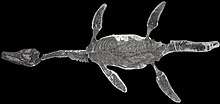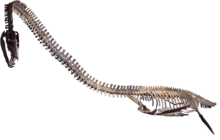Trinacromerum
Trinacromerum is an extinct genus of sauropterygian reptile, a member of the polycotylid plesiosaurs. It contains two species, T. bentonianum and T. kirki. Specimens have been discovered in the Late Cretaceous fossil deposits of what is now modern Kansas and Manitoba.[1]
| Trinacromerum Temporal range: Late Cretaceous | |
|---|---|
 | |
| A cast specimen of Trinacromerum kirki at the Royal Ontario Museum | |
| Scientific classification | |
| Kingdom: | Animalia |
| Phylum: | Chordata |
| Class: | Reptilia |
| Superorder: | †Sauropterygia |
| Order: | †Plesiosauria |
| Family: | †Polycotylidae |
| Genus: | †Trinacromerum Cragin, 1888 |
| Species | |
| |
Description

Trinacromerum with a human to scale
Trinacromerum was 3 meters (9.8 feet) long. Its teeth show that it fed on small fish.[1]
The long flippers of Trinacromerum enabled it to achieve high swimming speeds.[1] Its physical appearance was described by Richard Ellis as akin to a "four-flippered penguin."[2] Its name means "three tipped femur".
Classification

Profile view of a cast of a Manitoban specimen of Trinacromerum kirki

Trinacromerum bentonianum from the Late Cretaceous of Kansas
Below is a cladogram of polycotylid relationships from Ketchum & Benson, 2011.[3]
| Plesiosauroidea |
| |||||||||||||||||||||||||||||||||||||||||||||||||||||||||||||||||||||
References
- Ellis, Richard (2003). Sea Dragons: Predators of the Prehistoric Oceans. University Press of Kansas. p. 189. ISBN 0-7006-1269-6.
- Ellis, 190
- Hilary F. Ketchum and Roger B. J. Benson (2011). "A new pliosaurid (Sauropterygia, Plesiosauria) from the Oxford Clay Formation (Middle Jurassic, Callovian) of England: evidence for a gracile, longirostrine grade of Early-Middle Jurassic pliosaurids". Special Papers in Palaeontology. 86: 109–129. doi:10.1111/j.1475-4983.2011.01083.x.CS1 maint: uses authors parameter (link)
This article is issued from Wikipedia. The text is licensed under Creative Commons - Attribution - Sharealike. Additional terms may apply for the media files.




